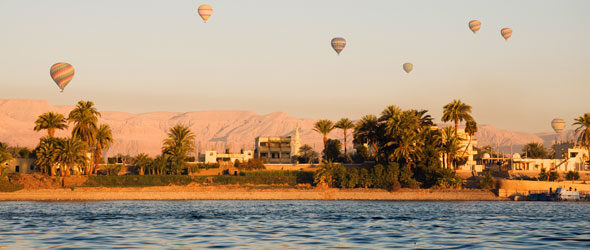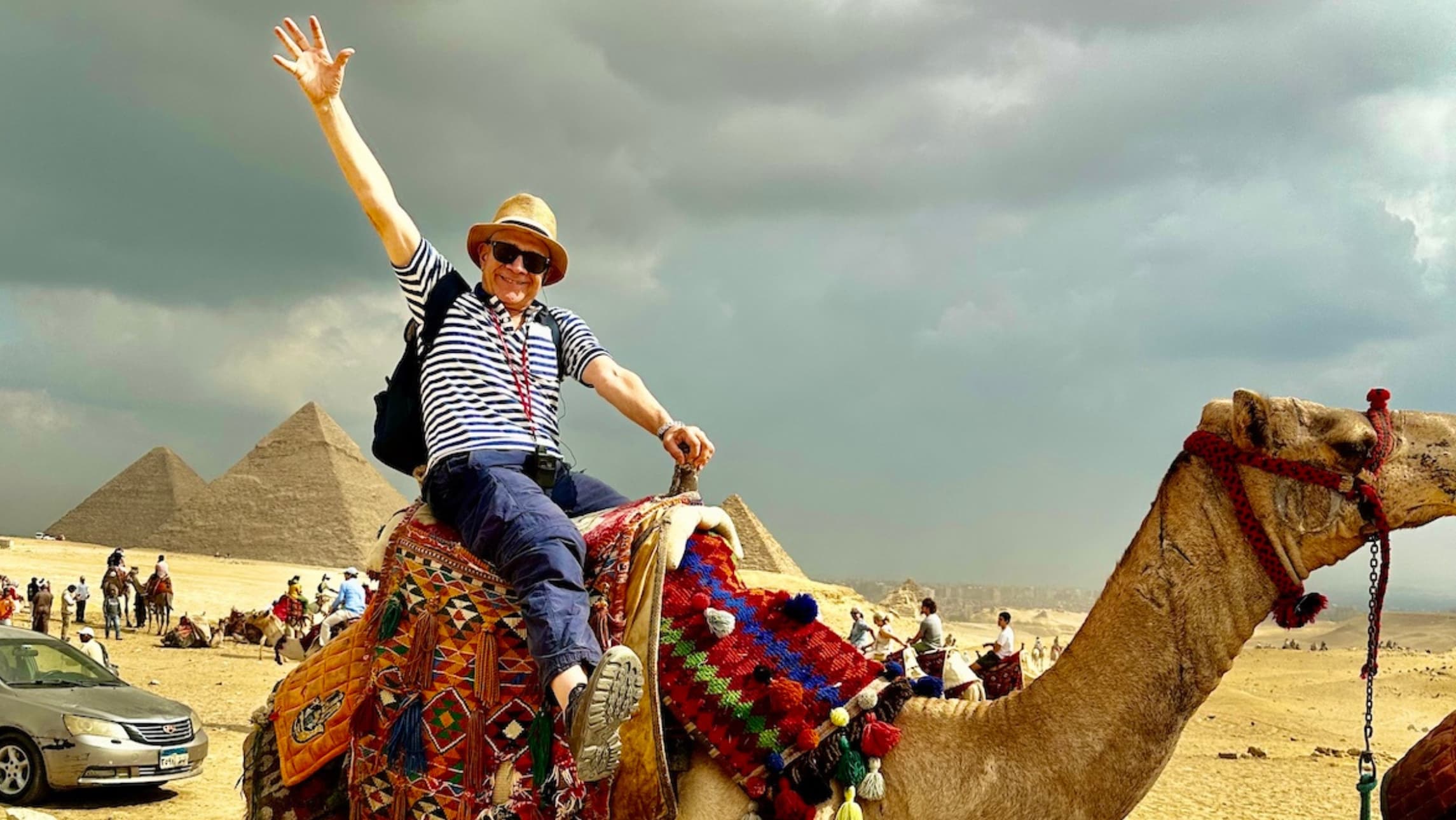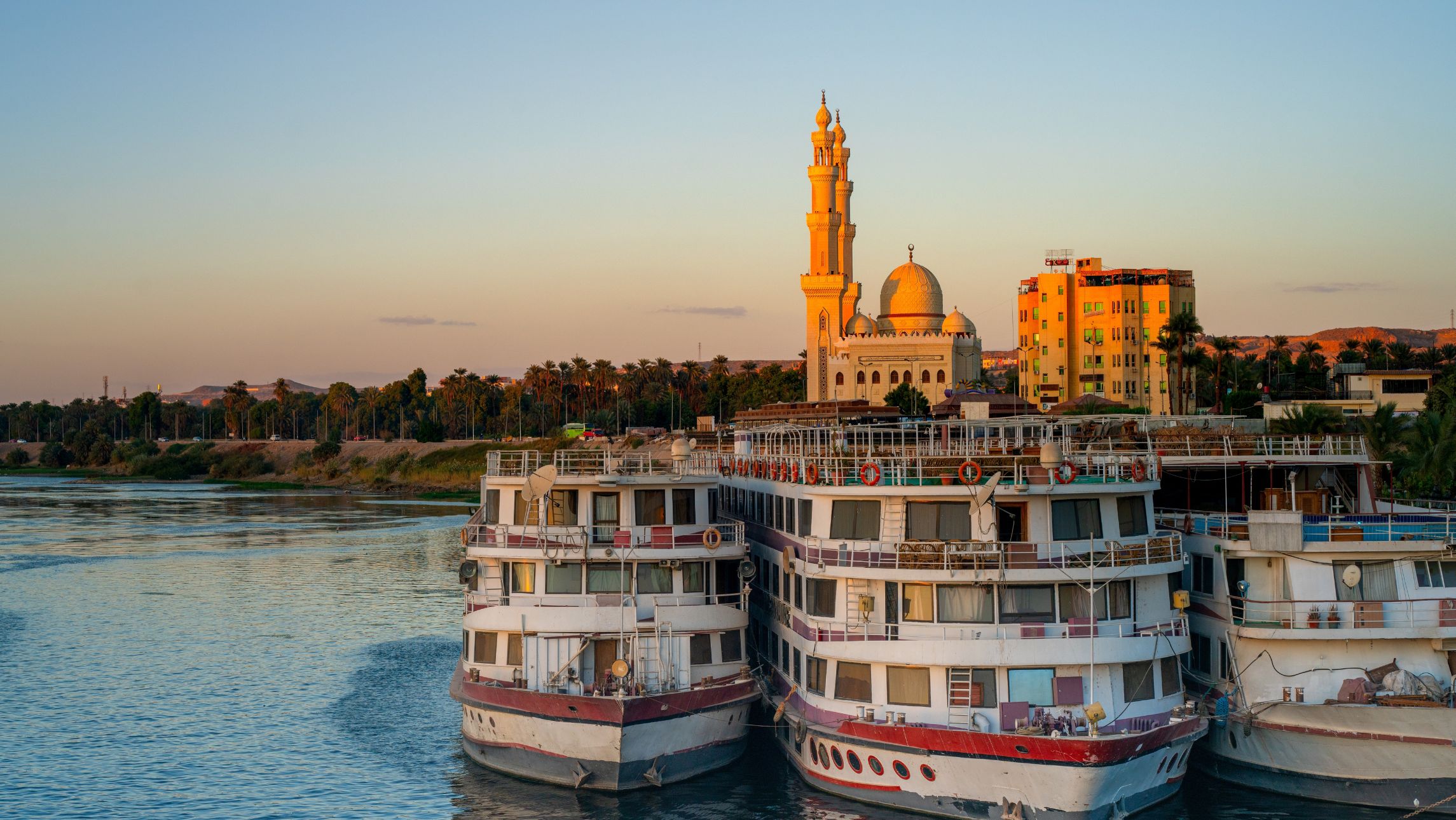A voyage along the Nile on board a traditional-style dahabiyya allows passengers a glimpse into a more leisurely, peaceful way of life. Words: Sue Bryant.
The breeze is cool as we putter across the Nile in pitch darkness on an unlit ferry, our luggage piled precariously on the roof, the bustle of the river bank at Aswan far behind. The river is inky, reed-encircled islands forming tufted shapes that loom out of the blackness. The toothless ferry driver appears to know the way without the need to see.
Eventually, welcoming lights loom into view. Three little dahabiyyas, the old-fashioned wooden sailing boats used by intrepid Victorian holiday-makers more than a century ago, are lined up along the bank. I am instantly charmed. We scramble aboard El Bey and are greeted with fresh mint tea (and, later, gin and tonics – it’s been a long day). I’m surprised at the level of comfort: polished wood everywhere, soft light filtering in geometric shapes through ornate lanterns, and cushions in vibrant colours piled on the sun deck. There are only six cabins, wood-panelled, each with its own shower room and period furnishings. We learn that these dahabiyyas are just a few years old, modern replicas of the originals.
The following morning, I am greeted by dazzling sunlight and the vision of a giant sand dune out of my window. Turquoise birds flit through the rushes along the bank. Fresh coffee is brewing on the shaded deck, where we have all our meals al fresco.
The pace of life on a dahabiyya turns out to be deliciously slow. We do all the same tours as passengers on the bigger boats (at Aswan, the beautiful Philae Temple and the High Dam, and further north, Esna and Edfu temples, Kom Ombo and the antiquities of Luxor), but move much more quickly than the tour parties, as our little group numbers just 12. As on the big river cruise boats, we have an Egyptologist on board for the whole seven-night cruise. Our expert, Maged, turns out to be an ace
at dominoes, resulting in many late-night challenges.
We also enjoy long, sun-soaked afternoons as we cruise north towards Luxor, lazing around on cushions and lounges on deck, reading, snoozing or just watching life on the river bank drift by – plantations of mango, lemon and banana, grubby children tending goats, buffalo standing like statues in the water.
The actual sailing part is more decorative than functional. The Nile flows south-north but the prevailing winds blow north-south, so a northbound voyage like ours is not ideal for filling the forward and aft sails. Accordingly, the voyage is mostly motoring, a luxury the Victorians did not enjoy. The crew, however, does hoist the sails once or twice on the rough, wooden masts and we tack lazily across the river in the afternoon breeze. Despite the impracticality of sailing, I do prefer the south-north option on the Nile, as it means saving the most dramatic antiquities, Karnak and the Valley of the Kings, for the grand finale.
The food on the dahabiyya is magnificent; easily as good as that on the big, luxury ships and all produced in the tiniest of galleys. On one day, there’s a surprise: a barbecue on an uninhabited island in the middle of the Nile, with a huge array of dips and salads, and Red Sea snapper grilling on the fire alongside lamb chops and chicken drumsticks. Evenings bring a mix of international cuisine and local specialties – curried chicken one night, pigeon another, spiced beef another, all beautifully presented. In this context, the free-flowing Egyptian wines served with dinner begin to taste extremely palatable, too.
Evenings are all the better as we’re usually moored at a quiet island midstream. The sound of braying donkeys mingles with the evening call to prayer as we break open the gin, and the comforting smell of wood smoke wafts from nearby villages hidden behind fields of sugar cane.
When we reach the hustle and bustle of Luxor, it’s quite a culture shock, with big cruise boats stacked three deep on the east bank, where the city lies (we’re tied up on the quieter west bank). The pace picks up as we tour the magnificent Luxor Temple, squeeze in the breathtaking Karnak Temple, the biggest of them all, and get up early to explore the intricate tomb paintings
in the Valley of the Kings. In February, the temperature is perfect: hot during the day but cool enough to wear a sweater at night.
We’ve splurged on one last treat before flying back to Cairo: a hot-air balloon ride. At the launch site, eight giant balloons are lying on the ground in the pre-dawn gloom, the roar of burners filling the air. We clamber into our basket, under the command of Captain Ali, and drift slowly upwards, just as the first rays of sun light up the geometric lines of the Temple of Queen Hatshepsut. The mountains turn to ochre and the whole of the Nile valley is suddenly bathed in golden light, a snake of emerald green winding across the desert beneath us.
It’s so magical that I never want it to end, although the farmer in whose field we land, frightening his donkey, has a less romantic view of the situation. After a lot of shouting and gesticulating, he is rewarded with a fistful of baksheesh (an all-encompassing Egyptian word for a tip). The balloons are loaded into trucks and life on the river bank returns to its normal calm rhythms.
Highs
Quiet nights moored at islands midstream; eating every meal on deck; barbecue lunch on a private island; touring the antiquities in a small group.
Lows
The only possible problem is not getting on with your fellow passengers, as you live and eat closely together. Many people travel with groups of friends, though individual cabins can be booked.
Fact File
Cruise Line: Bales Worldwide; vessel El Bey
(dahabiyyas Amber, Zahra and Musk are identical)
Star rating: Not applicable
Maximum passenger capacity: 12
Total crew: 8
Entered service: 2009 (for Bales)
Passenger decks: 2
Facilities: Small salon with books and games; deck sunbathing area. The best dahabiyyas on the Nile are operated by UK-based company Bales Worldwide. Cruises are priced in sterling, but Australian and NZ residents can book online at www.balesworldwide.com. A week costs from £1,165 per person (AU$1,857 at press time), including 7 nights full board, wine with meals, all sightseeing and tips.









Comments are closed.